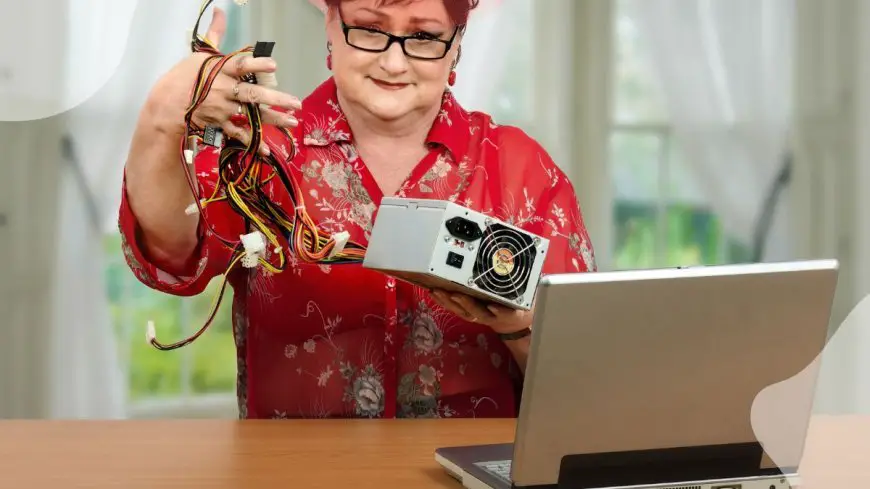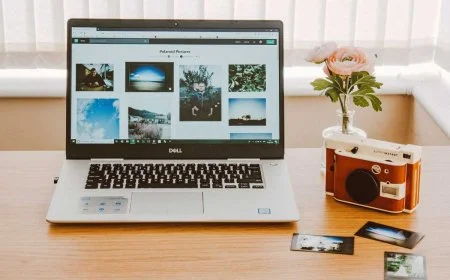How to Fix Power Supply on Laptop: Troubleshooting Guide
Learn how to fix power supply issues on your laptop with our comprehensive troubleshooting guide. Fix it yourself and save money!

Want to get your laptop up and running without the hassle of taking it to a repair shop for common hardware problems? Learn how to fix power supply issues on your laptop with our step-by-step guide. Discover the tips and tricks to troubleshoot and resolve common power supply problems, saving you time and money. Whether your laptop won't charge or is experiencing intermittent power issues, we've got you covered. Stay tuned to learn how to identify, diagnose, and fix power supply issues like a pro. Say goodbye to frustration and hello to a fully functional laptop in no time!
Key Takeaways
-
Identify Common Power Issues: Pay attention to common signs like sudden shutdowns or failure to charge to catch power supply issues early.
-
Troubleshooting Steps: Follow basic troubleshooting techniques like checking connections and restarting the laptop to resolve minor power problems.
-
Check AC Adapter: Test the AC adapter by using a multimeter or trying a different adapter to rule out adapter issues.
-
Repair Power Port: If the power port is loose or damaged, consider repairing it to ensure a stable power connection.
-
Battery Health: Monitor battery health through software tools and recalibration to extend its lifespan and maintain proper power supply.
-
Know When to Replace: Understand the signs indicating the need for part replacement, such as persistent power failures despite troubleshooting efforts.
-
Preventive Measures: Implement preventive measures like using surge protectors and avoiding overcharging to prevent future power supply issues.
Identifying Common Power Issues
Signs of trouble
Laptops experiencing power supply issues may exhibit various signs of trouble. Look for sudden shutdowns without warning, indicating a potential power problem. check for flickering or dimming of the screen, which could be linked to power irregularities. Lastly, listen for unusual noises like buzzing or clicking, as these could signal underlying hardware issues.
When to seek help
Knowing when to seek professional assistance is crucial when dealing with possible power supply issues on a laptop. If basic troubleshooting steps fail to resolve the problem, it's advisable to seek professional assistance. Similarly, if there are visible signs of physical damage to the laptop, contacting a technician is recommended. Moreover, if the laptop still doesn't power on after trying different solutions, it's time to consider expert help to diagnose and fix the issue.
Troubleshooting 101
Initial steps
To kick off the troubleshooting process, connect your laptop to a power source to ensure it's receiving adequate power. Next, remove any external devices connected to the laptop that might be causing interference. If necessary, hold down the power button to force a shutdown and reset the system.
Checking the adapter
Firstly, ensure that the adapter is securely plugged into the laptop to establish a proper connection for charging. Secondly, verify the adapter indicator light to confirm whether it's receiving power from the outlet. Lastly, check the adapter connection to the wall outlet to rule out any issues with the power source.
Power port inspection
Inspect the laptop's power port thoroughly for any debris or blockages that might be hindering the connection with the adapter. Look closely for any signs of physical damage on the power port such as bent pins or cracks. If necessary, clean the power port using compressed air to remove any obstructions.
Battery assessment
For battery assessment, test the laptop by removing the battery and utilizing only the power cable to determine if the issue lies with the battery itself. Examine the battery for any bulges or leaks, which could indicate a malfunction. Keep an eye on the battery health through the laptop settings to monitor its performance over time.
Diagnosing AC Adapter Problems
Indicator light check
When diagnosing power supply issues, start by checking the indicator light on the laptop. Look at its color to determine power status. Take note of any blinking patterns, as they can indicate specific problems. For a detailed understanding, consult the laptop manual to interpret the indicator light signals effectively.
Wall outlet test
To further diagnose power supply issues, plug another device into the same wall outlet where you usually connect your laptop. This step helps determine if the issue lies with the outlet itself. Use a voltage tester to confirm if electricity is flowing correctly from the wall outlet. If necessary, try plugging the laptop adapter into a different wall outlet to test for consistent power supply.
Adapter brick inspection
Inspect the adapter brick closely when troubleshooting power supply issues. Look for any signs of overheating, which could indicate a malfunction. Check the adapter cable for frays or damages that might be disrupting power flow. Ensure that the adapter brick is compatible with your specific laptop model to avoid compatibility issues and potential power disruptions.
Fixing the Power Port
Bent pin fix
Inspect the power connection port with a flashlight for any bent pins. Carefully straighten them using tweezers. Avoid excessive force to prevent further damage.
Double-check the connection between the adapter and laptop to ensure a secure fit. Make sure there is no strain on the adapter plug and power port.
Secure connection
Ensure a snug fit between the broken power adapter and your laptop. Avoid straining the extra power cable while using it.
Battery Troubleshooting
Removing and Reinstalling
-
Remove the battery to reset the power supply, then reinsert it after a minute.
-
Disconnect the power cable from the laptop and reconnect it securely to ensure a proper connection.
-
Restart the laptop after removing and reinstalling these components to check for any improvements.
Internal Battery Check
-
Research the specific laptop model to determine if it has an internal battery that may be causing power issues.
-
Contact the manufacturer for guidance on potential internal battery replacement procedures or recommendations.
-
Seek professional assistance if you suspect internal battery issues that require expert diagnosis and resolution.
Advanced Troubleshooting
Draining laptop electricity
Power off the laptop and unplug all cables. Press and hold the power button for 30 seconds to drain residual power. Reconnect the power cable and turn on the laptop to check for improvements.
Testing with a multimeter
Use a multimeter to measure the voltage output of the adapter. Compare the measured voltage with the required power for the laptop. Consult online resources for guidance on using a multimeter for testing.
When to Replace Parts
Adapter replacement
If your laptop is facing power supply issues, consider purchasing a new adapter if the current one is faulty. Look for adapters that are specifically compatible with your laptop model to ensure proper functionality. When buying a replacement adapter, always check for warranty options to safeguard your investment.
Battery change
When dealing with power supply problems, it might be necessary to research replacement battery options that are compatible with your laptop. Follow the manufacturer's guidelines meticulously to ensure a safe and effective battery replacement process. If you are uncertain about replacing the battery yourself, consider seeking professional assistance to avoid any potential risks.
Power port repair
In cases where the power port of your laptop is damaged, it is advisable to seek professional repair services to address the issue effectively. Before proceeding with the repair, inquire about the cost and feasibility of repairing the power port to make an informed decision. Remember to backup all important data before sending your laptop for power port repair to prevent any data loss during the repair process.
Preventative Measures
Regular checks
Establish a routine for checking the laptop's power supply components. Inspect the charging port for any debris or damage that may hinder proper connection. Monitor the battery's performance to ensure it holds a charge efficiently.
Create a maintenance schedule for cleaning and inspecting power-related parts. Regularly clean the fan vents to prevent overheating, which can impact the power supply. Check the power adapter for frayed wires or signs of wear.
Keep track of any changes in the laptop's power performance for early detection of issues. Note any sudden shutdowns or fluctuations in battery life. Document any abnormal behavior to address potential power supply problems promptly.
Safe usage tips
Avoid using third-party chargers not recommended by the manufacturer. Opt for original chargers to ensure compatibility and prevent damage to the laptop's power system. Verify the charger's specifications match those provided by the laptop manufacturer.
Unplug the laptop during electrical storms to prevent power surges. Disconnect all power sources, including chargers and adapters, to safeguard the laptop from electrical damage. Consider using surge protectors for added protection.
Store the laptop in a cool, dry place to maintain battery health. Avoid exposing the laptop to extreme temperatures that can degrade battery performance. Keep the laptop away from direct sunlight and moisture-prone areas.
Summary
You've now learned how to troubleshoot and fix common power supply issues on your laptop. By following the steps outlined in this guide, you can diagnose and resolve AC adapter problems, power port issues, battery troubles, and even tackle advanced troubleshooting scenarios. Knowing when to replace parts and implementing preventative measures can help you avoid future power supply issues. Remember, a well-maintained power supply is crucial for the optimal performance of your laptop.
Take charge of your laptop's power supply health by applying the knowledge gained here. Regularly check for signs of trouble, address them promptly, and follow best practices to keep your device running smoothly. Your proactive approach will ensure that your laptop remains powered up and ready for whatever tasks lie ahead.
Frequently Asked Questions
How can I identify common power issues with my laptop?
To identify common power issues, check for loose connections, listen for unusual sounds, look for error messages on the screen, and test different power outlets. Ensure the battery is properly inserted and inspect the power cord for any visible damage.
What are some preventative measures to avoid laptop power supply issues?
To prevent power supply issues, regularly clean the laptop vents, use a surge protector, avoid overcharging the battery, keep liquids away from the laptop, and update the operating system and drivers regularly. Handle the laptop with care to prevent physical damage.
When should I consider replacing parts in my laptop's power supply system?
Consider replacing parts like the AC adapter or battery if troubleshooting doesn't resolve the issue, there are visible signs of damage or wear, or if the components are no longer functioning effectively. Consult a professional technician for advice on specific replacements.
How do I troubleshoot the AC adapter of my laptop?
Troubleshoot the AC adapter by checking the power cord for any fraying or damage, testing different power outlets, ensuring a proper connection to the laptop, and using a multimeter to check for voltage output. If needed, try using a different compatible AC adapter.
Why is it important to fix the power port of a laptop promptly?
Fixing the power port promptly is crucial to ensure uninterrupted use of your laptop. A faulty power port can lead to charging issues, data loss due to sudden shutdowns, and potential damage to other internal components. Addressing this issue promptly can prevent further complications.
What's Your Reaction?







































![MacBook Pro M5: All the features and specs you need to know [LEAKS REVEALED]](https://tomsreviewbox.com/uploads/images/202502/image_430x256_67bd6d7cd7562.jpg)


























